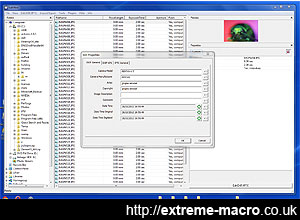Exif Pilot
by Johan J Ingles-Le Nobel
Last updated August 31, 2017
Exif Pilot is nice, free and easy to use exif editor that allows you to change exif settings in your photography with ease and speed, ideal for stacking in which exif settings are often lost because of the software used to stack.
What's nice about Exif Pilot is that it does both import and export functions, which means that you can import from a photograph and export the same settings to another, ideal for stacking.

Exif Pilot, a great little free proggie that lets you import and export EXIF. Perfect for stacking, in which EXIF usually gets lost.
For a finished stack, this is pretty handy, as the combined stack loses its exif data during the process of a stack and that way you can bring the exif data back in from one of the frames of the stack.
Exif
It's not that important to retain exif data in your photography and plenty of people make a point of deliberately hiding it.
Leaving the exif data in will give other photographers a good idea of how the photograph was actually made and not everyone wants others to know this sort of information, especially professional photographers in the highly competitive business of making a crust from their work.
Limited Exif
Bear in mind though that using the lenses we do, the amount of exif data that any image can have will always be somewhat limited.
In lenses like microscope lenses no electronic data is passed between lens and body so the exif made by the body will not include the lens data, its focal length or its aperture. Nor will exif data tell you the strength of the flash used (ie its manual setting used like 1/64). So exif will tell you a lot but it won't tell you everything. That said, you can always fill in fields manually with exif pilot.
Keeping Exif
does both import and export functions, which means that you can import from a photograph and export the same settings to another, ideal for stackingExif gets wiped when you use the "save for web" functionality with Photoshop, but when you use "save as" and set the format as jpg/jpeg, the exif data stays with the file. Exif also has standard tags for geolocation so it's quite a useful way to remember geolocation data for locations if you have a camera that has the GPS capability to insert that data.
Exif and Security
Since the Exif tag contains information about the photo, it can pose a privacy issue. For example, images taken with a GPS-enabled camera can reveal the exact location and time it was taken, and the unique ID number of the device - by default. Broadcasting the location of lots of expensive camera equipment especially if it's your house isn't usually such a great idea, and you can remove such data with exif pilot.
In December 2012, anti-virus programmer John McAfee was arrested in Guatemala while fleeing from alleged persecution in Belize, which shares a border. Vice (magazine) had published an exclusive interview with McAfee "on the run" that included a photo of McAfee with a Vice reporter taken with an Iphone 4S smart phone. The photo's metadata included GPS coordinates locating McAfee in Guatamala, and he was captured two days later.
Related Articles




